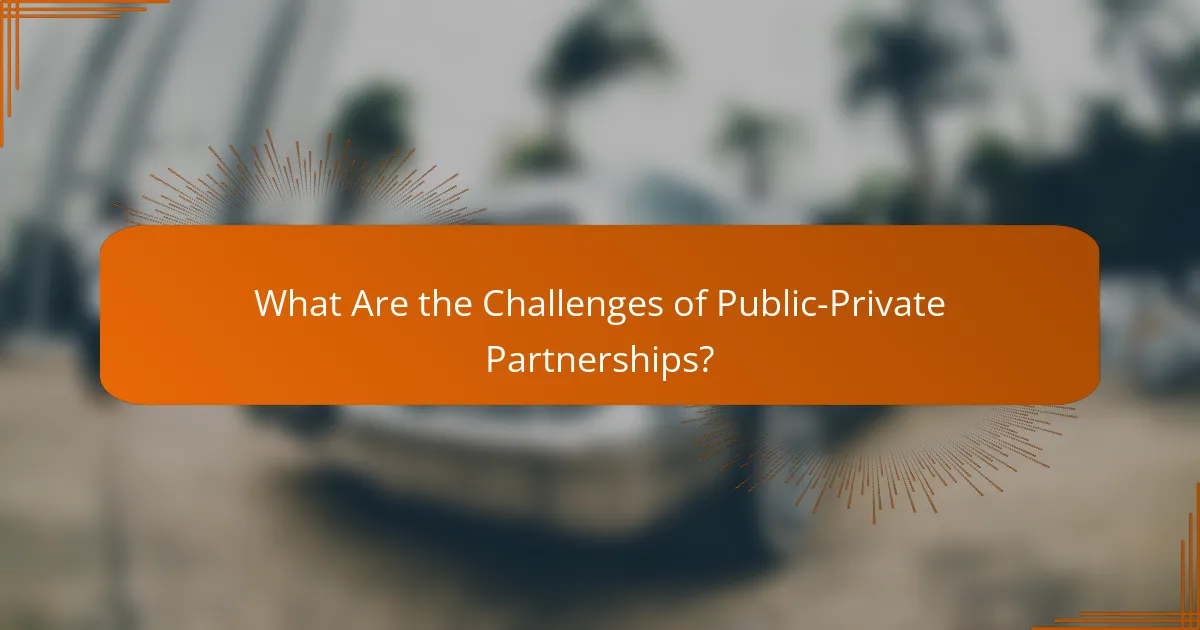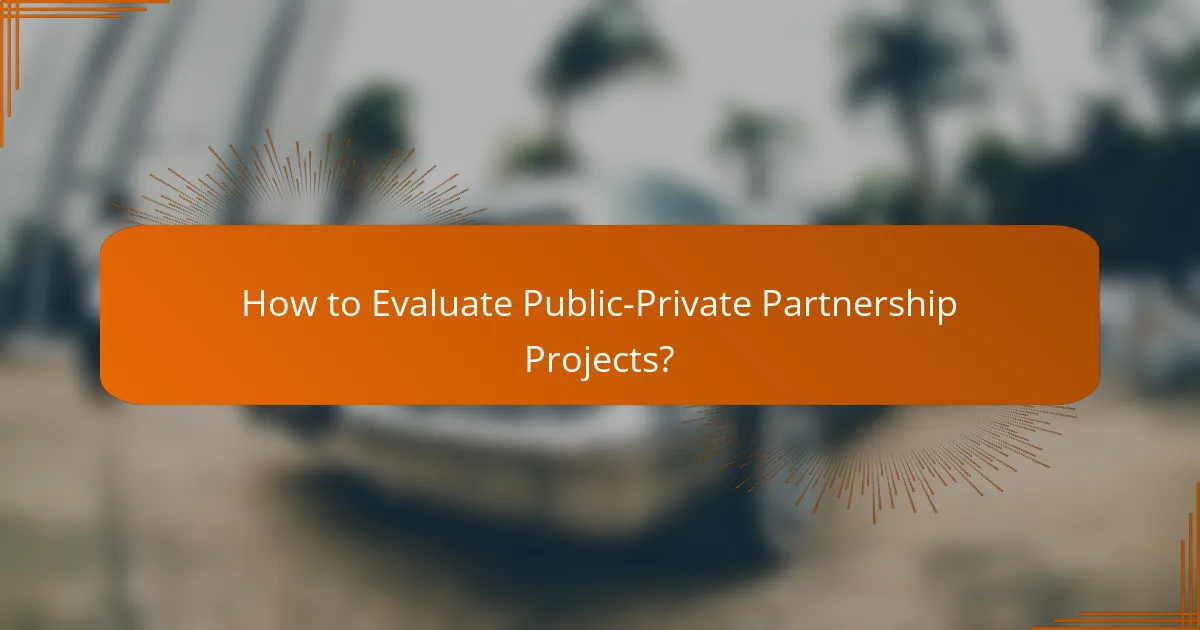Public-Private Partnerships (PPPs) represent a strategic collaboration between government entities and private sector companies aimed at financing and delivering essential public services and infrastructure projects. By combining private investment with public oversight, these partnerships enhance efficiency, foster innovation, and facilitate better risk management, ultimately leading to improved outcomes for communities. However, the effectiveness of PPPs can be challenged by regulatory hurdles, public perception issues, and funding limitations, which must be navigated to ensure successful collaboration.

How Do Public-Private Partnerships Work in Financing?
Public-Private Partnerships (PPPs) involve collaboration between government entities and private sector companies to finance and deliver public services or infrastructure projects. This model leverages private investment and expertise, allowing for shared risks and benefits in financing public initiatives.
Definition of Public-Private Partnerships
Public-Private Partnerships are cooperative agreements between public sector authorities and private sector companies. These partnerships aim to finance, design, implement, and operate projects that provide public services, such as transportation, healthcare, and education. By combining resources and expertise, both parties can achieve better outcomes than either could alone.
Key Financing Models
There are several financing models used in PPPs, including Build-Operate-Transfer (BOT), Design-Build-Finance-Operate (DBFO), and Joint Ventures. In a BOT model, the private partner builds the infrastructure, operates it for a specified period, and then transfers ownership back to the public sector. DBFO combines design, construction, and financing into one contract, while Joint Ventures involve shared ownership and risk between public and private entities.
Choosing the right model depends on project specifics, including financial capacity, risk tolerance, and the desired level of control. It’s essential to evaluate each model’s implications on funding, management, and long-term sustainability.
Benefits of Collaboration
Collaboration in PPPs offers numerous advantages, including access to private capital, innovation, and improved efficiency. By involving private firms, public projects can benefit from advanced technologies and management practices that may not be available within the public sector.
Additionally, sharing risks between public and private partners can lead to more balanced project outcomes. This partnership can enhance accountability and performance, as private entities often have incentives to deliver projects on time and within budget.
Examples of Successful Partnerships
Successful examples of Public-Private Partnerships can be found globally. In the United States, the I-495 Capital Beltway project in Virginia involved a PPP to expand and improve the highway, resulting in reduced congestion and enhanced safety. In the UK, the Private Finance Initiative (PFI) has been used for numerous healthcare facilities, allowing for quicker delivery of services through private investment.
These examples illustrate how effective PPPs can lead to significant improvements in public infrastructure and services, demonstrating the potential benefits of collaboration between sectors.

What Are the Benefits of Public-Private Partnerships?
Public-private partnerships (PPPs) offer numerous advantages, including enhanced efficiency, innovation, and risk management. These collaborations leverage the strengths of both sectors to deliver better services and infrastructure at reduced costs.
Cost Efficiency
Cost efficiency in public-private partnerships arises from the ability to combine public oversight with private sector expertise. By utilizing private funding and management, governments can often complete projects more quickly and at a lower overall expense.
For example, infrastructure projects financed through PPPs can reduce capital costs by 10-30% compared to traditional public funding methods. This efficiency is achieved through competitive bidding and the private sector’s drive for profitability.
Innovation in Service Delivery
Public-private partnerships foster innovation by encouraging private entities to introduce new technologies and practices. This collaboration can lead to improved service delivery, as private partners often bring cutting-edge solutions and operational efficiencies.
For instance, a PPP in the healthcare sector might involve a private company providing telemedicine services, enhancing access and reducing wait times for patients. Such innovations can significantly improve public services while keeping costs manageable.
Risk Sharing
Risk sharing is a fundamental aspect of public-private partnerships, distributing project risks between the public and private sectors. This arrangement allows both parties to leverage their strengths, with the private sector typically handling operational risks and the public sector managing regulatory and political risks.
In practice, this means that if a project encounters delays or cost overruns, the financial burden is not solely on the government. For example, a transportation PPP might allocate construction risks to the private partner, ensuring that taxpayers are protected from unforeseen expenses.

What Are the Challenges of Public-Private Partnerships?
Public-Private Partnerships (PPPs) face several significant challenges that can hinder their effectiveness. These challenges include regulatory hurdles, public perception issues, and funding limitations, each of which can impact the success of collaborative projects.
Regulatory Hurdles
Regulatory hurdles often complicate the establishment and operation of PPPs. Different jurisdictions may have varying regulations that govern public contracts, which can lead to confusion and delays. Compliance with local laws, procurement processes, and transparency requirements is essential but can be time-consuming.
For example, in the European Union, PPPs must adhere to specific directives that ensure fair competition and public accountability. Understanding these regulations is crucial for both public and private entities to navigate the partnership effectively.
Public Perception Issues
Public perception can significantly affect the success of PPPs. If the community views the partnership as prioritizing profit over public good, it may lead to resistance and distrust. Engaging stakeholders early and maintaining transparent communication can help alleviate concerns.
For instance, successful PPPs often involve public consultations and feedback mechanisms to ensure that the community’s needs are addressed. Building trust through consistent engagement can mitigate negative perceptions and foster a more collaborative environment.
Funding Limitations
Funding limitations are a common challenge in PPPs, as securing adequate financial resources can be difficult. Public entities may face budget constraints, while private partners might be hesitant to invest without clear returns. Establishing a balanced financial model is critical for sustainability.
To address funding issues, parties can explore various financing options, such as grants, loans, or blended finance approaches. Additionally, creating a detailed financial plan that outlines cost-sharing arrangements can help ensure that both public and private stakeholders are committed to the project’s success.

How to Evaluate Public-Private Partnership Projects?
Evaluating public-private partnership (PPP) projects involves assessing their feasibility, potential benefits, and risks. Key considerations include financial viability, stakeholder engagement, and alignment with public objectives.
Criteria for Success
Successful PPP projects typically meet several criteria, including clear objectives, strong governance structures, and effective risk-sharing mechanisms. Projects should align with public interests while providing value to private partners.
For instance, a well-defined project scope and measurable outcomes can enhance accountability and performance. Engaging stakeholders early in the process helps ensure that the project meets community needs and expectations.
Risk Assessment Frameworks
Risk assessment frameworks for PPP projects help identify, analyze, and mitigate potential risks throughout the project lifecycle. Common risks include financial, operational, and regulatory challenges that can impact project success.
Utilizing a structured approach, such as a risk matrix, can aid in prioritizing risks based on their likelihood and potential impact. Regular reviews and updates to the risk assessment are essential to adapt to changing circumstances and maintain project viability.

What Are the Trends in Public-Private Partnerships?
Public-private partnerships (PPPs) are increasingly characterized by innovative financing models, collaborative frameworks, and a focus on sustainable development. These trends reflect a shift towards leveraging private sector efficiency while addressing public needs through shared resources and expertise.
Emerging Technologies
Emerging technologies play a crucial role in enhancing the efficiency and effectiveness of public-private partnerships. Innovations such as blockchain, artificial intelligence, and data analytics can streamline processes, improve transparency, and facilitate better decision-making. For instance, blockchain can provide secure and transparent tracking of project milestones and financial transactions.
Additionally, the integration of smart technologies in infrastructure projects can lead to improved service delivery and maintenance. Cities are increasingly adopting smart grids and IoT solutions to optimize energy use and enhance public services.
Focus on Sustainability
Sustainability is a central theme in modern public-private partnerships, driven by the need to address climate change and promote environmental stewardship. Projects are increasingly evaluated based on their long-term sustainability impacts, including energy efficiency, waste reduction, and social equity. For example, partnerships in renewable energy projects often prioritize sustainable practices and technologies.
Governments and private entities are also aligning their goals with global sustainability frameworks, such as the United Nations Sustainable Development Goals (SDGs). This alignment encourages investments in green infrastructure and promotes resilience against environmental challenges.
Global Case Studies
Global case studies illustrate the diverse applications and successes of public-private partnerships. In Europe, the UK’s Private Finance Initiative (PFI) has been used to fund various infrastructure projects, demonstrating how private investment can accelerate public service delivery. Similarly, in Australia, the use of PPPs in transportation projects has led to significant improvements in urban mobility.
In developing countries, PPPs have been instrumental in expanding access to essential services. For instance, partnerships in India have successfully enhanced water supply and sanitation facilities, showcasing how collaborative efforts can address pressing public needs while attracting private investment.

What is the Future of Public-Private Partnerships?
The future of public-private partnerships (PPPs) is poised for growth, driven by increasing collaboration between governments and private entities to address infrastructure and service delivery challenges. These partnerships are evolving to incorporate innovative financing models and technology, enhancing efficiency and effectiveness in public service provision.
Emerging Trends in Public-Private Partnerships
Emerging trends in PPPs include a greater focus on sustainability and digital transformation. Governments are increasingly seeking partnerships that not only deliver services but also promote environmental responsibility and social equity. Additionally, the integration of technology in PPP projects is becoming essential, enabling smarter infrastructure solutions.
Another trend is the rise of hybrid financing models that combine public funding with private investment. This approach allows for more flexible funding arrangements, reducing the burden on public budgets while leveraging private sector expertise and innovation.
Key Considerations for Successful PPPs
Successful public-private partnerships require careful planning and clear communication between stakeholders. It is crucial to define roles, responsibilities, and expectations from the outset to prevent misunderstandings. Establishing a strong governance framework can help manage risks and ensure accountability.
Financial viability is another key consideration. Both parties should conduct thorough financial assessments to ensure that the project is sustainable and that returns on investment are achievable. Engaging with local communities early in the process can also enhance project acceptance and support.
Challenges and Risks in Public-Private Partnerships
Challenges in PPPs often include regulatory hurdles, funding constraints, and differing objectives between public and private partners. Navigating complex regulatory environments can delay project timelines and increase costs. It is essential to stay informed about local regulations and compliance requirements to mitigate these risks.
Moreover, misalignment of goals can lead to conflicts. Establishing a shared vision and maintaining open lines of communication can help align interests and foster collaboration throughout the project lifecycle.
Examples of Successful Public-Private Partnerships
Successful examples of public-private partnerships can be found across various sectors. In transportation, projects like toll roads and bridges often involve private investment to enhance infrastructure while ensuring public access. In healthcare, partnerships between governments and private firms have led to improved service delivery and innovation in patient care.
In Europe, the UK’s Private Finance Initiative (PFI) has been used to finance schools and hospitals, demonstrating how PPPs can effectively deliver public services while sharing risks and benefits. These examples highlight the potential of PPPs to address pressing societal needs through collaborative efforts.



